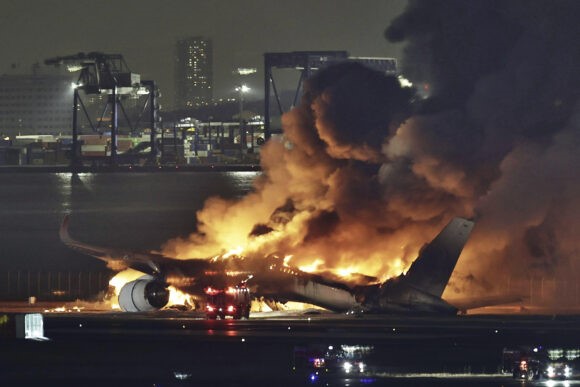Insurer AIG Leads Policy for Japan Airlines Plane Involved in Runway Collision

Japan Airlines (JAL) on Thursday said it expected losses of more than $100 million after one of its planes was destroyed when it collided with another aircraft on the runway at Tokyo’s Haneda airport this week.
All 379 people on board the JAL Airbus A350 widebody jet escaped before the plane was completely engulfed in flames that took more than six hours to extinguish.
But five of the six crew of the other aircraft – a smaller Coast Guard plane that was in its third mission to deliver aid to quake-hit regions on Japan’s west coast – were killed, with the surviving pilot badly injured.
As investigators combed the charred wreckage on Thursday, transport authorities are probing the circumstances that led to the Coast Guard plane entering the runway where the passenger jet was landing. Police are also looking into possible professional negligence in the case, according to media reports.
Transcripts released by authorities show air traffic control ordering the Coast Guard plane to proceed to a holding point near the runway minutes before the crash, instructions the pilot appeared to have read back in acknowledgement.
Japanese authorities said on Wednesday the passenger jet had been given permission to land, but the smaller plane had not been cleared for take-off, based on the transcripts.
The Coast Guard pilot said after the crash that he had been given permission to enter the runway, Coast Guard officials have said.
Authorities have only just begun their investigations and aviation experts say it usually takes the failure of multiple safety guardrails for an airplane accident to happen.
A notice to pilots in force before the accident suggested that a strip of stop lights embedded in the tarmac as an extra safety measure to prevent wrong turns, was out of service, according to a copy of the bulletin posted by U.S. regulators.
Haneda was the world’s third-busiest airport in 2023, according to UK-based travel industry data provider.
On the day of the accident, a public holiday in Japan, the airport was at full capacity, said Shigenori Hiraoka, director general of the Civil Aviation Bureau.
The doomed Coast Guard plane was making its third emergency trip to an earthquake zone within 24 hours when the accident occurred, Reuters revealed on Thursday.
Japan Transport Safety Board (JTSB) is leading the safety investigation, and has been joined by 14 overseas investigators from Airbus, French and British authorities as well as one representative from the jet’s engine maker Rolls Royce, a JTSB official said. Police are conducting their own investigation in parallel, the official said.
Big Losses
JAL estimated on Thursday the disaster would result in an operating loss of about 15 billion yen ($105 million).
The loss of the aircraft should be covered by insurance, the company said, adding it was assessing the impact on its earnings forecast for the financial year ending March 31. The airline was discussing compensation individually with passengers, two of whom had pets that died in the incident, JAL officials said.
Insurance industry sources have said U.S. insurer AIG was the lead insurer on a $130 million “all-risks” policy for the two-year-old plane that was destroyed by the fire. AIG declined to comment.
It was the first-ever hull loss globally for the A350 model, according to Aviation Safety Network. The type, made largely from carbon composite, entered commercial service in 2015.
Shares of JAL fell as much as 2.4% as trading resumed after the New Year’s holidays, before closing up 0.8%.
From the moment of the collision, it took crew 18 minutes to get everyone off the plane and safely accounted for.
Most of the passengers on the flight from Hokkaido were Japanese with at least 43 foreigners confirmed among them including Australians, Swedish, Hong Kong, Chinese and South Korean nationals, a JAL spokesperson said.
Wreckage from the planes remained scattered around the runway on Thursday as several officials, some wearing masks, gloves and hard hats, surveyed the debris, footage on public broadcaster NHK showed. A Coast Guard official on Wednesday said they had recovered a voice recorder from the Coast Guard plane.
Hundreds of flights in and out of Haneda have faced cancellation or delays since the crash on Tuesday, leaving many frustrated passengers at the airport.
Michio Kusunoki, a 67-year-old teacher, said he had faced two canceled flights as he tried to return to his home of Fukouka in Japan’s south from Haneda.
“I was meant to get on a plane yesterday evening at 7.30 p.Then I changed to this morning 8:30 a.m. and that flight was canceled too,” he said.
“I couldn’t get anything after that till 4:30 p.m. so I am going to roam around as I can’t get home.”
($1 = 143.1100 yen)
U.S. insurer AIG was the lead insurer on a $130 million “all-risks” policy for the Japan Airlines airplane which collided with another plane at Tokyo’s Haneda airport, two insurance industry sources said on Wednesday.
AIG declined to comment.
All 379 people aboard the Japan Airlines Airbus A350 escaped after a collision with a De Havilland Dash-8 Coast Guard turboprop that killed five of six crew on the smaller aircraft.
Source : Insurance Journal, Photograph: A Japan Airlines plane is on fire on the runway of Haneda airport on Tuesday, Jan. 2, 2024 in Tokyo, Japan. (Kyodo News via AP)
By Daniel Leussink, Nobuhiro Kubo and Kaori Kaneko 4 January 2024
